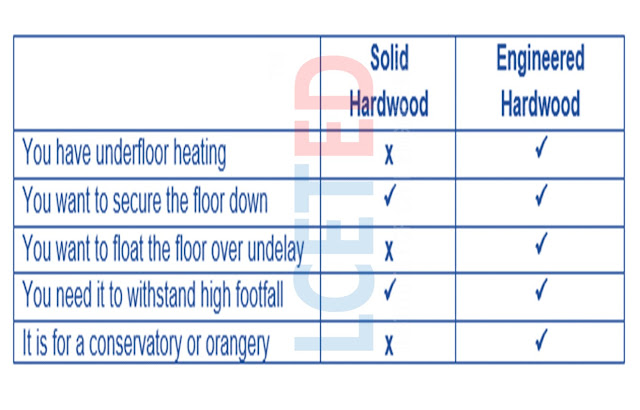What Is The Difference Between Engineered Hardwood And Solid Hardwood?
As
the name implies solid wood is completely solid wood. The engineered wood is
made in layers
The top layer is a hard veneer and the bottom, layers of wood (or layers).
In
general, these canvases are perpendicular to the direction and are laminated
together (like plywood), in general (but not always), although these canvases
are made of wood and are not the same species as the top layer.
|
Engineered wood |
Solid wood |
|
|
Basics |
Engineering wood is the layered product that contains a useful but thin
hardwood base on a high quality plywood base. |
Nothing but solid wood and hardwood, the same product top to bottom and
side to side. |
|
Thickness, Width |
The thickness can vary from 3/8 inch to 1/2 inch. Standard widths are 3
1/4 inches, with board sizes starting at 5 inches wide. |
Standard width starts at 2 1/4 inches wide. The width of the boards can range from 5 inches to 11 inches wide. The thickness is typically 3/4
inches. |
|
Prefinished
vs. Finished site |
Engineering wood bases are pre-finished, although some companies create
finished engineered hardware on site. |
Pre-finished coating of choice for solid wood
floors increasing Today, the finished (also known as unfinished)
site contains about 25 % hardwood. |
|
Sanding |
One of the biggest differences between solid and engineered wood is
sanding. The engineered wood can be sanded, but lightly once or twice before
wearing the thin top layer. |
Solid wood can be sanded multiple times. By sanding solid wood will
become too thin after years of sanding, compromising its structural
integrity. |
|
Installation |
Engineering wood is simpler than solid wood because there are a variety
of installation methods, including staple or nail, folding and locking or
glue. |
Solid wood flooring is nailed or stapled. It is never installed on a
mobile base. |
|
Durability |
Wood bases are durable, but not comparable to solid wood. Since the
surface is thin, it can be chipped or de-laminated if stressed beyond normal
conditions. However, its ability to withstand low humidity helps to improve
its tolerance |
A well-maintained solid wood the floor will last for decades. Moisture is the enemy of this biological product. Wooden bases have a chance to
recover after a flood, but they will never return to their previous shape. |
|
Humidity |
Engineering wood is better than solid wood for handling moisture. Its
plywood base is dimensionally stable, meaning it is more easily deformed in
contact with moisture than solid wood. Plywood runs in cross layers, which is
a much more stable structure than parallel solid wood fibres. |
Solid wood is never recommended for bathrooms, foundations or other
areas where humidity is high or expected. However, solid wood can resist
moisture. However, the wood floors on the floor (as opposed to pre-finished)
have a sealed top layer that releases some moisture. |
Is Engineered Wood durable?
Good
quality engineered wood is durable and resistant to moisture. Engineered wood
is suitable for making modular kitchens, shelving, and cabinets, and can be
finished with veneer or laminate. Furniture made of synthetic wood is
affordable, easy to make, and durable.
ALSO READ: What
is Engineered Wood? | Types | Manufactured Woods | Uses
Hopefully,
this article was helpful to you……………..







No comments:
Post a Comment